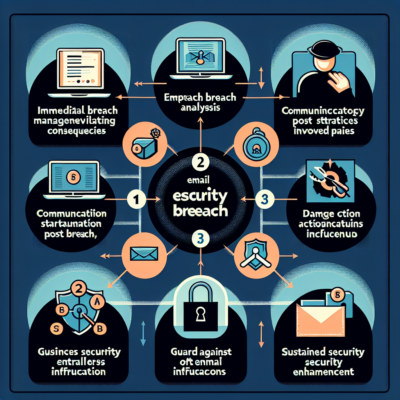
The Your Email Security Breaches Cure To
In this digital era, Email Security Breaches has become very common and is a big threat for organizations irrespective of size. Phishing and malware such as ransomware brought in by email is scary, especially after the fact. Designed to be a comprehensive guide for any organization going through the aftermath of an email security breach this practical, solid advice from experienced practitioners and their case studies are sure to help with resilience and protection to prevent further attacks.
Next Steps After a Breach
When an email security breach is discovered, time plays a role in either minimizing the amount of destruction and access provided, or allowing it to continue doubling down on the damage. First Step here is…
1. Isolate Affected Systems
Immediately quarantine the affected email systems and accounts to arrest further penetration. Isolate infected devices from the network, and deactivate any hacked email accounts.
2. Change Passwords
All users (especially the affected) are required to reset their email passwords immediately. Enable multi-factor authentication (MFA) to improve security.
3. Notify IT and Security Teams
Quickly notify your IT and security teams This will allow them to start the process of uncovering where and how the breach originated.
4. Perform Immediate Risk Assessment
Conduct an initial breach response assessment to determine the nature of the incident, e.g., whether it were related to phishing or malware etc.
5. Secure Backups
Test the: Backups – across all file types; ensure files are encrypted This must be at first in the event that you have to reestablish your information.
Assessing the Impact
You will want to finalize the immediate risks and begin looking into what the security breach has done or can do. This also includes identifying what data was breached & its business ramifications.
1. Data Analysis
Investigate logs and audit trails to work out how the breach occurred, and what data was accessed. Seek out unusual patterns of activity that might indicate additional compromise.
2. Damage Assessment
Since each breach directly or indirectly impacts the operations of an organization, and its financial status placing a risk in terms of reputation. This can also be in relation to legal implications and data protection compliance.
3. Engage Forensic Experts
You may also want to think about bringing in cybersecurity forensic specialists who can help with breach investigation. Having such professionals can make you determine the scope and more importantly, avoid future breaches.
Informing Stakeholders
Stakeholder communication should be fully transparent before and after an email breach Ensuring that everyone can be informed then you are able to trust the coordination of efforts during recovery.
1. Establish Breach Notification Plan
Develop a prevention plan, include how you will communicate with employees if this happens to them and when do contact your customers and confide in people involved. The NTT should include key messages and contact points for more information.
2. Inform Employees
Send timely communications to your employees detailing how and why the breach occurred, what the company is doing about it, as well as any necessary changes that need to be made – like ask them reset their password or keep an eye out for phishing emails.
3. Notify Customers and Partners
Notify your customers and business partners whose data has been subject to the breach. Be open about what is happening and let them know how they are being protected instantly, hence reducing the spread of misinformation.
Implementing Actions to Correct
Having qualified the damage and potential affected stakeholders, it is now time to start working on remediation actions to close vulnerabilities that can help in securing your email.
1. Update Software and Patches
Check for important patches or security updates on your email client and every other software installed on the EC2 instances.
2. Review and Update Security Policies
Update your security policies at the organizational level This means tightening email security protocols and making sure all staff adhere to the best practice approaches.
3. Conduct Security Audits
Conduct broad security audit to find some left over exposures. Use It to Improve Your Security Posture.
4. Monitor Systems
Make sure to always keep a close eye on your email systems and nothing seems out of the ordinary. Deploy next-generation threat detection technology to discover and stop threats in real-time.
Preventing Future Breaches
Addressing resilient email security requires an effort beyond immediate remediation.
1. Security Awareness Training
What to do Invest in Security Awareness HNG for employees Agreed! Teach them about the most recent threats and how to identify phishing, etc.
2. Adopt Enterprise Security Solutions
Installing advanced email security to include: Email encryption, Malware detection & Whitelisting.resolve the vulnerabilities that exist in an organization.
3. Implement Incident Response Plans
Establish comprehensive incident response plans with precise actions to take if a breach occurs via email Keep updating and testing these plans, so that they really work during an emergency.
Conclusion: Constructing the Resilience Post-Breach
There is no question email security breaches are difficult to manage, but they can also serve as an opportunity for organizations. The most important thing you should do during such times is to respond immediately, evaluate the extent of influence on your network or business operations followed by transparent communication, take stringent remediation actions and steps so that a breach like this never occurs in future so as to completely make use lean security Firmware develpment.
Just remember that security team work and continuous improvement are key. Use every incident as a learning experience to develop proactive email security strategies.